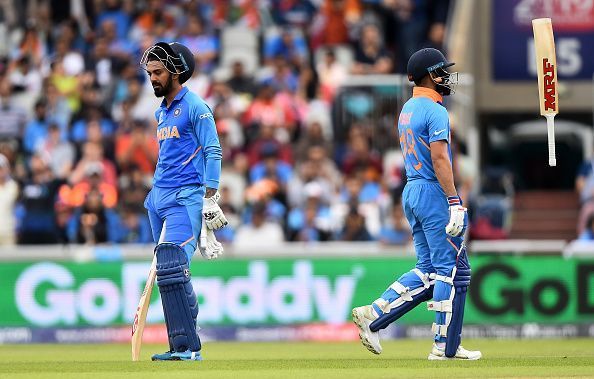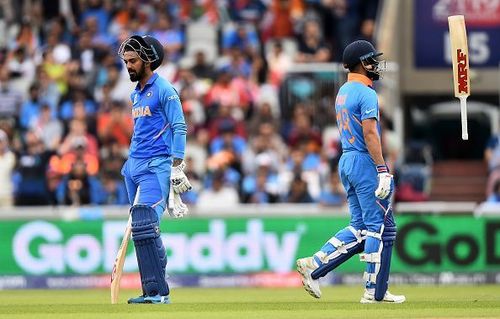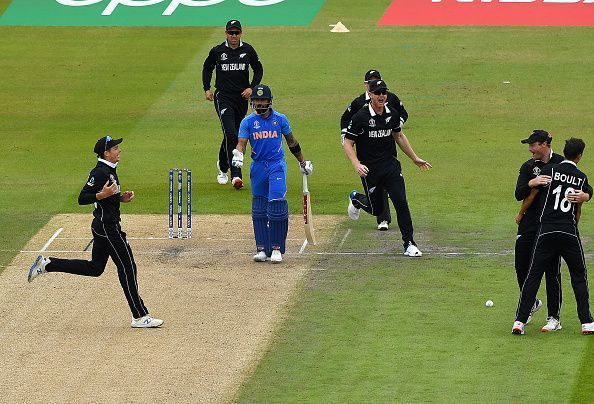
World Cup 2019: Anatomy of India's semi-final defeat to New Zealand

The first semifinal of the 2019 ICC Cricket World Cup in Manchester pitted league toppers and tournament favorites India against New Zealand, with the Black Caps managing to scrape through to the last four by the skin of their teeth. It was a match-up which materialized, albeit a tad fortuitously.
Australia unexpectedly tripped up against already-eliminated South Africa in their last league game, a result coupled with India's win over Sri Lanka, helped India usurp the Aussies to top place in the league, in the process ensuring second-placed Australia would lock horns with hosts England in the 'tougher' second semifinal in Edgbaston.
A comfortable group stage phase
India navigated the league phase of the tournament successfully by through a fine show from the top three of Rohit Sharma, Shikhar Dhawan/ KL Rahul and Virat Kohli scoring prolifically to set up a platform for the big hitters like Pandya and Dhoni to flourish. The bowlers would then turn up and complement the batting effort - a template which served the team well, but its flaws propped up every now and then.
On days the top three struggled to get going, as in the match against Afghanistan on a tough but surely not diabolical pitch, the inability of the middle order to rotate the strike or conjure the occasional big hits was glaring. The runs choked up, the innings never got out of third gear and only a fine collective bowling effort helped stave off an embarrassing defeat against a modest opposition.
The chinks in the armour were exposed once again in games against the West Indies and hosts England. This was none more evident than in the game with the hosts, where Pandya's quickfire innings prepared the stage for Dhoni and Kedar Jadhav to launch a final assault of a stiff target.
Quite shockingly though, as the required rate mounted, the duo were content to play out dots and singles, prematurely shutting up shop, leaving ex-players and connoisseurs alike scratching their heads in disbelief at the all too apparent lack of effort or intent to go for the win.
A familiar stumble in the knockout stages
Soon it was time for the knockouts and with it arrived the moment of truth. Two wins away from a third World Cup triumph. New Zealand, supposedly the weakest of the semifinal quartet, awaited table toppers India. The Black caps won the toss, batted first and posted a final total of 239 which was largely considered underwhelming against a strong Indian top order.
But on a slow pitch where the ball seamed early on, the much spoken about Indian batting line-up floundered. For once, Rohit Sharma, the first player to score five hundreds in a single World Cup campaign, fell early.
It was a setback which soon metamorphosed into a concern and then into a raging crisis when captain Kohli failed to cover the line of a vicious in-swinger from Boult to be trapped in front and Rahul fished fatally outside his off-stump.

In three eventful overs, the top three were sent back and the team's brittle middle order lay brutally exposed. It was the opportune moment for a seasoned campaigner like MS Dhoni to join ranks with the exuberant Rishabh Pant, blunt the Kiwi new ball attack and get a partnership going. Yet, at this instance Dinesh Karthik, mostly known for his finishing prowess, walked in and expectedly struggled to get going.
Karthik scratched around for a while till Jimmy Neesham's fine diving catch ended his misery and left India sinking further down an abyss. The score stood at 24-4 after ten overs and yet Dhoni was still held back, for reasons best known to the team management. In walked Hardik Pandya - a flamboyant batter not known for his defensive skills.
Quite fortuitously though, a restrained Pandya and the unorthodox Pant began stitching together a semblance of a partnership but the asking rate by now soared to above seven an over. The Kiwis were meticulously choking the run flow and a release shot from either youngster seemed all too imminent.
Pant was the first to run out of patience and holed out at deep midwicket off the impressive Santner. Dhoni was held back no further but by now the damage was already done. Pandya followed suit soon after and Ravindra Jadeja - a player considered surplus to requirements till the last league game, arrived at the crease.
Jadeja's lusty hits in the company of a watchful Dhoni turned the match on its head and brought India to the precipice of an unlikely win. The equation petered down to 52 runs off the last five overs. It was the final curve before the home straight. With two set batsman and big hitters at the crease, it was a stiff but achievable target. The time had come for Dhoni to open up and complement Jadeja.
Dhoni, quite bizarrely, still remained content with singles and twos at this juncture. Jadeja went for one big hit too many and perished in the process, leaving India with a massive 31 runs off the last 12 balls. Dhoni was now left with no other recourse but to unleash the long handle but it was too little too late.
A brilliant direct hit from Martin Guptill, as he ran in from square leg caught Dhoni short of the crease and with it, doused a billion hopes of a third World Cup triumph. For once, the master chaser got his calculations wrong and the fallibility of his favoured template of taking every game deep was in greater scrutiny than ever before.
He has done it successfully many a time and it does look spectacular when it comes off, but the obvious downside to it is too grave to be ignored - when Dhoni takes a chase deep and fails, the new man often walks in to a situation beyond salvage.
A weak middle order - The missing piece in India's puzzle
Of course, MS Dhoni and his preferred mode of chasing a target was not the singular reason for India's failed World Cup campaign. For a start, the team sorely lacked power hitters in the middle order - one of the most pertinent requirement of the modern game. Players like Rayudu and Jadhav just did not fit into this mould and yet they were persisted with for far too long.
The vital no. 4 position remained a question unanswered. Vijay Shankar and Pant were tried at this slot, with the consequences ranging from unsatisfactory to disastrous, when either would have been better lower down the order. A big hitter and utility bowler like Ravindra Jadeja was carrying drinks till the penultimate league game when he should have played in every game.
The bowling strategy was flawed too. For a make or break game like the semis, where defeat would send the team home regardless of how it fared in the league stage, playing five bowlers to lengthen the batting was an extremely risky proposition. Not to mention the downright dubious composition of the bowling personnel. A wicket taking bowler like Shami was benched in favour of Bhuvaneshwar Kumar, supposedly because of the latter's superior batting prowess.
An attack minded impact player like Rishab Pant was not part of the original squad. Even when he did replace the injured Dhawan in the squad, he was warming the bench despite the continued failures of a few others, under a pretext of not disturbing a winning combination, till Shankar's injury opened up a slot in the XI.
An inflexible team strategy on the day of the semifinal also cost dear. A pair of right handed openers, who both take their time to get going, played right into the Kiwis’ hands. India needed a right-left combination to upset the Kiwi bowlers’ rhythm and start the chase with cautious aggression.
As it transpired, the openers started too circumspectly, Rohit and Virat were soon back in the hut, and the chase never got going in right earnest. It was the perfect scenario for a senior pro like Dhoni to stride out to the middle at the fall of the third wicket, absorb the pressure, steady the ship and more importantly see off the opening burst from the Kiwi new ball bowlers when the ball was seaming.
Given the relatively modest target and three big hitters in Karthik, Pandya and Jadeja to follow, the net run rate was going to be a non- issue for the latter part of the innings.
Dhoni could have taken his time to get his eye in and steer a partnership with Pant, who could have counter-attacked judiciously and keep the scoreboard ticking. Pant's eventual dismissal was directly attributable to the absence of a calm and experienced head at the other end who would have eased out the youngster's fraying nerves.
As the dreams of a third World Cup triumph lay in tatters for another four years, it is perhaps time players past their prime call time on their career and an attacking template for the ODI game is adopted.
Like-minded young players such as Shreyas Iyer, Prithvi Shaw, Shubman Gill and Khaleel Ahmed need to be brought in and allowed the freedom to express themselves. For the next World Cup is only four years away and the spadework for the same ought to begin in right earnest.
Also read – World cup winners list
Follow Sportskeeda for all the updates on World Cup points table, news, World Cup most runs, live scores, schedule, most runs, most wickets and fantasy tips.